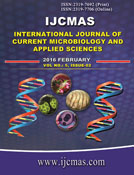


 National Academy of Agricultural Sciences (NAAS)
National Academy of Agricultural Sciences (NAAS)

|
PRINT ISSN : 2319-7692
Online ISSN : 2319-7706 Issues : 12 per year Publisher : Excellent Publishers Email : editorijcmas@gmail.com / submit@ijcmas.com Editor-in-chief: Dr.M.Prakash Index Copernicus ICV 2018: 95.39 NAAS RATING 2020: 5.38 |
Pneumonia is one of the most common public health infectious disease and one of the major cause of morbidity and mortality in elderly and immunocompromised(IC) patients. The mortality rate increases considerably when pneumonia is associated with the development of complications. This study is conducted to identify the current patterns of Community Acquired Pneumonia (CAP) complications, associated IC states and to analyze its microbiological profile. Patients above 18 years presenting with signs and symptoms of pneumonia during the study period were included. Associated complication patterns were documented. Various respiratory samples were collected aseptically and processed according to Standard Operating Procedures. The isolated microbial agents and their antimicrobial susceptibility pattern were identified according to CLSI guidelines. Out of the total 150 patients in the study group, 19.99% of them presented with one of the complications of CAP. Diabetes mellitus (48%) was the most common associated IC state followed by hematological malignancies (18.66%). Most common complication is bacteremia (9.33%), followed by pleural effusion (6%). Complications are more common in patients with associated IC state (70%) than in patients who are immunocompetant (IP) (30%) with statistical significance. Multidrug Resistant organisms are more commonly associated with complications (73.33%). Methicillin Resistant Staphylococcus aureus (36.67%) and Klebsiella pneumoniae (30%) were the most common bacterial agents identified in association with pneumonia complications. With antibiotic therapy being the main stay of treatment in CAP and with definitive treatment patterns for associated complications, proper knowledge of host factors, currently prevailing complication patterns, etiological agents and their resistance pattern pave an effective way to formulate empirical antibiotic therapy.
 |
 |
 |
 |
 |